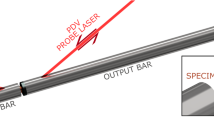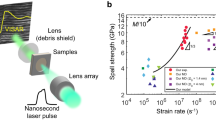Abstract
FOR metals undergoing slow deformation at elevated temperatures, it has been shown that nucleation of voids by condensation of lattice vacancies requires either a very high concentration of excess vacancies (approximately 100 times the equilibrium value1), or very high concentration of stress2. It appears that such concentrations of vacancies are never approached even at high rates of deformation3, so that voids must form at points where sufficiently large stresses develop. It has been suggested that ledges on a sliding grain boundary may provide these sites for nucleation.
This is a preview of subscription content, access via your institution
Access options
Similar content being viewed by others
References
Seitz, F., Acta Met., 1, 355 (1953).
Brinkman, J. A., Acta Met., 3, 140 (1955).
Buffington, F. S., and Cohen, M., Trans. Amer. Inst. Min. Met. Eng., 194, 859 (1952).
Gifkins, B. C., Acta Met., 4, 98 (1956).
McLean, D., Inst. Metals Mon. and Rep. Series, No. 23, 159 (1957).
Anderson, N. G., and Dawson, I. M., Proc. Roy. Soc., A, 218, 255 (1953).
Author information
Authors and Affiliations
Rights and permissions
About this article
Cite this article
DAVIES, P., DENNISON, J. Void Nucleation Sites in Creep of Metals. Nature 182, 131–132 (1958). https://doi.org/10.1038/182131b0
Issue Date:
DOI: https://doi.org/10.1038/182131b0
This article is cited by
-
Fictional mechanism explanations: clarifying explanatory holes in engineering science
European Journal for Philosophy of Science (2022)
-
Stress/Strain Induced Void?
Archives of Computational Methods in Engineering (2021)
-
Cavitation in creep
Journal of Materials Science (1974)
Comments
By submitting a comment you agree to abide by our Terms and Community Guidelines. If you find something abusive or that does not comply with our terms or guidelines please flag it as inappropriate.



